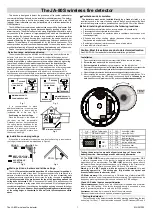
26
Function Code Group
Group
Number
Register Example Using Equation 1
Code
Name
J1
PID Control 1
48
J100: (48 x 256) + 0 + 1 = 12289
:
J199: (48 x 256) + 99 + 1 = 12388
4.2
Scanned Function Codes
The interface card provides network access to the specified list of function codes contained in the
param.xml
file located in the “
WEB
” folder of the interface card’s file system. These function codes are
constantly being read and/or written (as applicable), and their current values are therefore mirrored in
the interface card’s internal memory. Only those function codes specified in the
param.xml
file will
represent meaningful values.
The principle disadvantage of scanned function codes is that write data checking is not available. This
means that when the value of a scanned function code is modified via a network protocol or via the web
browser’s monitor tab, the interface card itself is not able to determine if the new value will be accepted
by the inverter (the value may be out-of-range, or the inverter may be in a state in which it will not accept
new values being written via communications, etc.) For example, if a write is performed to a scanned
command function code with a data value that is out-of-range, the interface card will not generate a
corresponding error. However, if end-to-end confirmation of such data writes is required, then the
function code can be read over the network at a later time to confirm that the written value “took hold” in
the inverter.
Accesses to any function code (?00…?99, where “?” is any valid function code group letter from Table
14) will always be successful. Even if an inverter function code corresponding to a given register does
not exist in the
param.xml
file, the interface card still maintains a placeholder location in its internal
mirroring memory for that function code. This feature allows for the block access of non-contiguous
registers (function codes) as described in section 4.1. Care must be taken to utilize only the function
codes that are known to exist and that are also specified in the
param.xml
file.
4.3
Commonly Used Function Codes
For a complete listing of all available function codes, their bit mappings, scaling values, etc., please refer
to the
Fuji FRENIC-Ace Instruction Manual (INR-SI47-1733a-E)
and the
Fuji RS-485 User’s Manual
(24A7-E-0082)
. As a user convenience, the structures of the commonly-used “Operation command”
(function code S06), “Operation status” (function code M14) and “Rotation Speed” (function code W08)
are replicated here (refer to Table 15, Table 16 and Table 17, respectively).
Table 15: Structure of “Operation command” (Function code S06)
















































